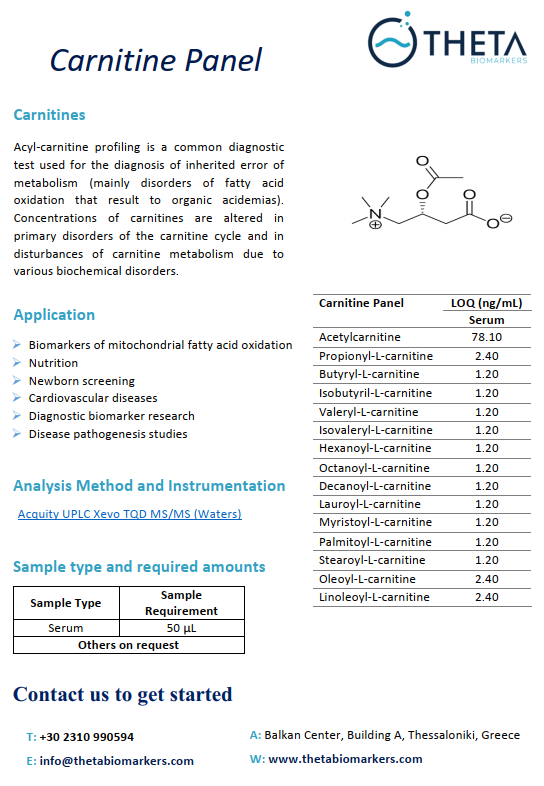Acylcarnitines Profile
Acylcarnitines are an acetylated form of L-carnitine naturally produced by the human body or obtained through diet. These esters are considered essential for the catabolism of fatty acids and for the maintenance of energy homeostasis in the human body. Acylcarnitines have many important functions including the control of several mitochondrial enzymes activity.
A plethora of studies have shown that there are several disorders linked to acylcarnitine metabolic defects, so they are important diagnostic markers for complex diseases and fatty acid oxidation disorders (FAODs).
Acylcarnitine regulations have been associated with insulin resistance, cardiovascular disease, and Alzheimer’s disease.
Blood plasma is the preferred sample type for acylcarnitine analysis (Meikopoulos et al.).
Applications
Available Tests
Acylcarnitine analysis in plasma
Acetylcarnitine
Decanoyl-L-carnitine
Propionyl-L-carnitine
Lauroyl-L-carnitine
Butyryl-L-carnitine
Myristoyl-L-carnitine
Isobutyril-L-carnitine
Palmitoyl-L-carnitine
Valeryl-L-carnitine
Stearoyl-L-carnitine
Isovaleryl-L-carnitine
Oleoyl-L-carnitine
Hexanoyl-L-carnitine
Linoleoyl-L-carnitine
Octanoyl-L-carnitine
Related Articles
A HILIC-MS/MS method development and validation for the quantitation of 13 acylcarnitines in human serum, Meikopoulos, T. et al.
Correlation of Serum Acylcarnitines with Clinical Presentation and Severity of Coronary Artery Disease, Deda O. et al.
Prognostic significance of metabolomic biomarkers in patients with diabetes mellitus and coronary artery disease, Karagiannidis E. et al.
Lab Report Writing – an Introduction
Lorem ipsum dolor sit amet, consectetur adipisicing elit, sed do eiusmod tempor incididunt ut labore et dolore magna aliqua. Ut enim ad minim veniam, quis nostrud exercitation ullamco laboris nisi ut aliquip ex ea commodo consequat duis aute irure dolor in
Where can I go to provide a sample for testing?
Our country possesses approximately 170 billion barrels of oil that can be recovered with today’s technology. Of that number, 165 billion barrels are located in the oil sands.
What happens to my sample once I have provided it?
Our country possesses approximately 170 billion barrels of oil that can be recovered with today’s technology. Of that number, 165 billion barrels are located in the oil sands.
How long does testing typically take before results are available?
Our country possesses approximately 170 billion barrels of oil that can be recovered with today’s technology. Of that number, 165 billion barrels are located in the oil sands.
What will laboratory testing cost me?
Our country possesses approximately 170 billion barrels of oil that can be recovered with today’s technology. Of that number, 165 billion barrels are located in the oil sands.

